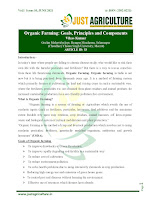C4 cycle or
Hatch and Slack pathway
It is the alternate pathway of C3
cycle to fix CO2. In this
cycle, the first formed stable compound
is a 4 carbon compound viz., oxaloacetic acid. Hence it is called C4 cycle. The path way is also called as Hatch and Slack
as they worked out the pathway in 1966 and it is also called as C4 dicarboxylic acid pathway. This pathway is
commonly seen in many grasses, sugar cane, maize, sorghum and amaranthus.
The C4 plants show a different type
of leaf anatomy. The chloroplasts are dimorphic in nature. In the leaves of these plants, the vascular bundles
are surrounded by bundle sheath of larger parenchymatous cells. These bundle sheath cells have chloroplasts. These chloroplasts of bundle sheath are larger,
lack grana and contain starch grains. The chloroplasts
in mesophyll cells are smaller and always contain grana. This peculiar anatomy of leaves of C4 plants is called Kranz
anatomy. The bundle sheath cells are bigger and look like a ring or wreath. Kranz in German means wreath and hence it
is called Kranz anatomy. The C4 cycle involves
two carboxylation reactions, one taking place in chloroplasts of mesophyll cells
and another in chloroplasts of bundle sheath cells. There are four steps in Hatch and
Slack cycle:
1.
Carboxylation
2. Breakdown
3. Splitting
4. Phosphorylation
1.
Carboxylation
It takes place in the chloroplasts of
mesophyll cells. Phosphoenolpyruvate, a 3 carbon compound picks up CO2 and changes into 4 carbon
oxaloacetate in the presence of water. This reaction is catalysed by the enzyme,
phosphoenol pyruvate carboxylase.
|
| ||||||
|
|
2.
Breakdown
Oxaloacetate breaks down readily into
4 carbon malate and aspartate in the presence
of the enzyme, transaminase and malate
dehydrogenase.
These compounds diffuse from the mesophyll
cells into sheath
cells.
3.
Splitting
In the sheath cells, malate and aspartate split enzymatically to yield free CO2 and 3 carbon pyruvate. The CO2 is used in Calvin’s cycle in the sheath cell.
The second Carboxylation occurs in the chloroplast of bundle
sheath cells. The CO2 is accepted
by 5 carbon compound ribulose diphosphate in the presence of the enzyme,
carboxy dismutase and ultimately
yields 3 phosphoglyceric acid. Some of the 3 phosphoglyceric acid is utilized in the
formation of sugars and the rest regenerate ribulose diphosphate.
4.
Phosphorylation
The pyruvate molecule is transferred to chloroplasts
of mesophyll cells where, it is phosphorylated
to regenerate phosphoenol pyruvate in the presence of ATP. This reaction is catalysed
by pyruvate phosphokinase and the phophoenol pyruvate
is regenerated.
The Hatch and Slack pathway, the C3 and C4 cycles of carboxylation are
linked and this is due to the Kranz
anatomy of the leaves. The C4 plants are more efficient in photosynthesis than
the C3 plants. The enzyme,
phosphoenol pyruvate carboxylase of the C4 cycle is found to have more affinity for CO2 than the ribulose
diphosphate carboxylase of the C3 cycle in fixing the molecular CO2 in
organic compound during Carboxylation.
Thank You
Vikas Kashyap :)















0 Comments